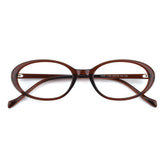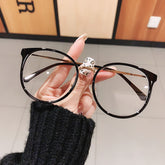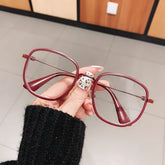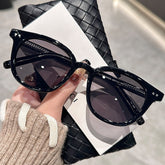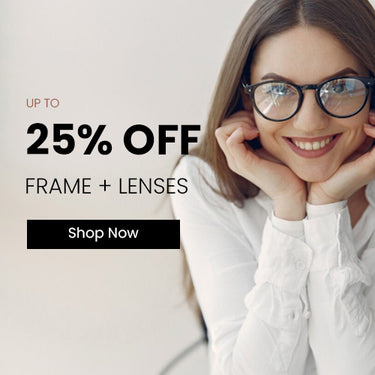Different Types of Lenses for Glasses
When it comes to selecting the right pair of glasses, choosing the correct lens type is just as important as finding the perfect frame. The type of lenses you choose can greatly impact your vision, comfort, and even the overall appearance of your glasses. In this blog, we’ll explore the most common types of lenses for glasses and what makes each one unique.
| Lenses Types | 1 Single Vision Lenses | Reading Lenses | Used to see near |
| Distance Lenses | Used to see far | ||
| 2 Multi Focal Lenses | Bifocal Lenses | Used to see near & far | |
| Progressive Lenses | Used to see near & far & middle | ||
| 3 Plano Lenses | Non-Prescription Lenses | No vision correction, often made as blue blocker glasses or accessories to complete the look | |
| 4 Peripheral Defocus Lenses | Myopia Control Lenses | Used to to slow the progression of myopia | |
1. Single Vision Lenses
Single-vision lenses have one prescription power throughout the entire lens. They are the most common type of lens and are typically used to correct either nearsightedness (myopia) or farsightedness (hyperopia).
- Reading Lenses: The lenses are designed to magnify text or small objects, making them easier to see without squinting or straining your eyes. These lenses typically have a positive diopter value, allowing you to choose the level of magnification that best suits your needs.
- Distance Lenses: Used for ndividuals with myopia who struggle to see distant objects clearly. These lenses typically have a negative diopter value, which helps focus light correctly on the retina, providing clear vision at long distances.
2. Multi Focal Lenses:
Multifocal lenses are eyeglass lenses designed to correct vision at multiple distances—near, intermediate, and far—within a single lens.
- Bifocal Lenses: The lenses allow users to see clearly at both near and far distances with a single pair of glasses. They are designed with wo distinct sections—one for distance and one for near vision—are separated by a visible line across the lens, providing a convenient solution for individuals who need correction for both near and far distances without switching between different pairs of glasses.
- Progressive Lenses: They are ideal for individuals who need correction for near, intermediate, and distance vision but want a more modern and aesthetically pleasing option than bifocals. Best for people who prefer a modern, line-free lens design that offers a more natural visual experience.
3. Plano Lenses:
Plano lenses are typically used by individuals who do not need vision correction but want the look of wearing glasses or need eye protection.They are often chosen for their ability to block harmful UV rays, filter blue light from screens, or simply enhance personal style with fashionable frames.
4. Peripheral Defocus Lenses:
Peripheral defocus lenses are a specific type of defocus lens that targets the peripheral (outer) regions of the retina. The primary purpose of defocus lenses is to slow the progression of myopia by manipulating how light is focused on the retina. The lenses are designed to create a slight blur (defocus) in certain peripheral areas of the retina, which helps regulate eye growth.
-What' are peripheral defocus lenses technologies?
- Essilor: DIMS – Defocus incorporated multiple segments
- Hoya: HAL – Highly Aspherical Lenslet Target

DIMS (Defocus Incorporated Multiple Segments) and H.A.L.T. (Highly Aspherical Lenslet Target) technology are innovative optical technologies used in myopia control lenses. Both technologies are designed to slow the progression of myopia in children and young adults, but they operate in different ways.
-Peripheral defocus spectalcle lenses brands and products:
| Essilor | Stellest, Myopilux Plus, Myopilux Max |
| Hoya | MiYOSMART |
| Zeiss | MyoCare, MyoVision Pro, Myokids |
-Who Can Use Peripheral Defocus Lenses?
- Children with Progressive Myopia: Typically, children and adolescents between the ages of 6 and 18 are the primary candidates, as this is the age group where myopia often progresses rapidly.
- Young Adults with Myopia Progression: Although myopia progression slows down in adulthood, some young adults may still experience changes in their vision. Peripheral defocus lenses can be beneficial for those who continue to have progressive myopia.
- Individuals at High Risk of Developing High Myopia: If there is a family history of high myopia, or if a child is already showing signs of rapid myopia progression, peripheral defocus lenses can be an effective preventive measure.
- Patients Seeking Proactive Myopia Management: Parents who are concerned about their child’s rapidly worsening myopia may choose peripheral defocus lenses as part of a comprehensive myopia management plan.
Choosing the right type of lens is crucial for both your vision and overall comfort. Whether you need single-vision lenses for everyday use, progressive lenses for seamless multifocal correction, plano lenses for blue light blocking or peripheral defocus lenses to slow down the progress of myopia, there’s a solution tailored to your needs. Consult with your optometrist to determine which lens type is best for vision requirements, and then you may choose different lens usage and lens index according to your lifestyle and needs.


